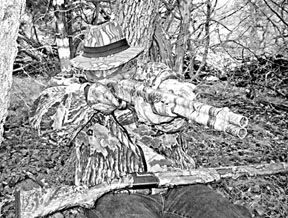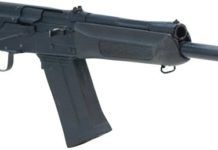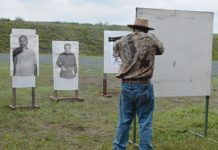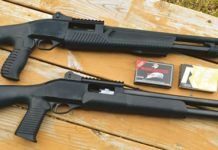
The concept of a shotgun specifically designed for a specific function in the shooting community is not new.
For example, single-barrel trap shotguns with lengthy barrels, tight chokes and high ribs are the culmination of extensive research and development to provide the shooters with a tool specifically designed for their sport.
However, there can be situations where the average hunter might just scratch his head and wonder, “What could those research and development guys have been thinking?” when looking over some products on the market.
Such is the case with the idea of producing short-barreled over-and-under shotguns created for turkey hunters hiding in heavy brush to wait in ambush for big birds.
While a short firearm can mean greater ease in movement for the hunter (who should be keeping motion to a minimum if he expects to lure any wary turkey within shooting range), there are many downsides to reduced barrel lengths.
Short barrels can result in increased muzzle blast; sharper recoil from a lighter firearm; and poor patterning performance — just to name a few problems.
A check of any of the clay target shooting fields, where hitting your targets means the difference between failure and fame, will find that length does matter. Barrels of less than 26 inches in length are as rare as tom turkeys with 18-inch beards.
Unless the shotgun is extremely well balanced, attempting a smooth motion with a short-barreled scattergun is like trying to swing a baseball bat while holding on to the opposite end from the handle.
Add the recoil of hard-hitting 3-inch and 3.5-inch shotgun shells to the equation, along with the increased muzzle blast closer to the ears of the shooters, and the results may not be very pretty.
Such is the case with the 20-inch-barreled Heckler & Koch Fabarm Camo Turkey Mag 12 gauge, No. 2010194, $1,295, made in Italy by Fabarm and distributed by H&K of Sterling, Va.
Described by one of the members of our test group as “a shotgun in contrast with itself,” the heavy walnut stock, complete with a palm swell at the grip, and the skeletonized top lever are fine attributes normally reserved for upper-end shotguns. Both features add class to the firearm that looks more like a toy than a heavy duty turkey gun.
The Realtree Camo paint scheme on all parts of the firearm are well done on most areas, although the finish on the inside of the trigger guard was rough and showed signs of peeling.
As expected from its balance and light weight, this shotgun packed a punch at both ends and was not a pleasing shooting experience.
A competing product, clad in Break-Up Camo finish, the Fausti Traditions Turkey II 12 gauge No. S084212405, $1,169, is manufactured by Fausti of Italy and imported by Traditions of Old Saybrook, Connecticut. It seems to be a little more acceptable as a turkey firearm than its H&K counterpart.
Sporting 24-inch barrels, which performed much better in swing tests conducted by our test group, the walnut stock and forearm, in addition to the barrels, are painted in Break-Up Camo. The receiver, trigger guard and top lever are black, with acid-etched engraving of a turkey on the receiver.
Like the H&K, the shotgun can blend into the brush well and become hard to spot — even by sharp-eyed turkeys.
When we put these products to the test, we fired Winchester 3-inch 1.75-ounce No. 4 and Winchester 3.5-inch 2-ounce No. 4 turkey loads, both with a muzzle velocity of 1,300 fps; Remington 3-inch 1 5/8-ounce No. 4 turkey loads with a muzzle velocity of 1,225 fps; and Remington 3.5-inch 1.75-ounce No. 4 turkey loads with a muzzle velocity of 1,300 fps. In addition, our clay target tests were conducted with Remington Premier STS Light Handicap 2.75-inch 1 1/8-ounce No. 7 1/2 shot with a muzzle velocity of 1,200 fps.
Here’s our test report:
[PDFCAP(1)]
A member of our test group actually said “What were they thinking?” as this shotgun was removed from its case. Short, light barrels with most of the weight in the stock forecast a bruising shooting experience for our group using heavy turkey loads.
In this case, the forecast was correct.
Our test gun measured 37.25 inches in overall length with an LOP of 14.5 inches. Drop at the comb was 1.5 inches and drop at the heel was 2.25 inches. The 20-inch barrel featured a “Picatinny rail” quick-detachable scope base that serves as a rear sight. Very unbalanced with most of its weight in the stock and receiver, this shotgun weighed 7.25 pounds.
It sported an extremely heavy trigger pull of 10 pounds for the bottom barrel and 15 pounds for the top. During many of the shooting situations, the trigger touched and even jammed into the trigger guard. Quick second shots were almost impossible because of the jammed trigger and heavy trigger pull.
Also, a combination of its light weight and short barrels resulted in a very sharp recoil from both 3-inch and 3.5-inch shells, despite the thick rubber recoil pad. In addition, the leather covering on the recoil pad began to peel after only a few test shots.
Surprisingly, the shotgun’s shell extraction system featured only extractors and not ejectors that are commonly found in any shotgun whose price tops the $1,000 mark. Turkey hunters probably won’t be firing a lot of ammunition in a hurry, but having a firearm that ejects shells, rather than one that forces the shooter to pull them from the chambers, should be an expected feature.
Another surprise with the H&K package was the set of choke tubes accompanying the test firearm. In addition to two ported Super Turkey chokes (which provided little recoil relief) there were five other chokes in the set. How and when the short-barreled shotgun could be used in situations requiring a cylinder or improved cylinder choke were questions that could not be answered by our test shooters.
Patterns produced by the H&K Super Turkey chokes were marginal at best, with both the 3-inch and 3.5-inch shells resulting in very bottom-heavy hits (only 30 percent of the shot was in the top 50 percent of a 30-inch circle). There was no difference between the two different loads on the turkey head and neck targets, with both shells placing an average of only 7.33 pellets in the kill area at a range of 30 yards.
To give this performance some perspective, a recently tested Mossberg Model 935 semi-automatic 12 gauge with a 28-inch barrel and full choke tube produced an average of 15 killing hits in the turkey head and neck targets.
Swinging the 20-inch barrels on any moving target was extremely difficult, and the very heavy trigger pull did not allow any consistent firing performance. We did appreciate the palm swell on the grip, which allowed for firm control of the shotgun, and the safety just behind the skeletonized top lever provided easy access as both a safety and barrel selector.
[PDFCAP(2)]
From the very start, this shotgun handled much better than the H&K, with more of its weight in the forearm and barrel areas. Four more inches of barrels made a world of difference in balance, with a little difference in concealment.
Our test gun had an overall length of 41.5 inches, with its 24-inch barrel. The length of pull was 14.25 inches, with a drop at the comb of 1.5 inches and drop at the heel of 2.5 inches.
Our testers noted poor wood-to-metal fit of the shotgun’s stock to its receiver. In some places, the wood extended up 1/8 inch above the metal.
Slightly heavier than the H&K, the Fausti tipped the scales at 7.5 pounds and more of its weight was forward of the forearm — resulting in its better handling ability, we thought.
The trigger pull for the Fausti was heavier than the normal 5-pound range of most out-of-the-box shotguns, with the bottom barrel tripping at 7.75 pounds and the top barrel dropping the firing pin at 8 pounds.
While the pattern performance of the shotgun was slightly better than the H&K, with an average of 35 percent in the top 50 percent of a 30-inch circle, the killing group in the head and neck area of the turkey target averaged only 7 pellets with both 3-inch and 3.5-inch shells.
The Fausti appeared to favor 3-inch ammunition, with one shot of a 3.5-inch Remington Hevi-Shot Magnum shell fired through the extra-full choke resulting in no killing pellets in the turkey head and neck target.
Our test group expected more from both the Fausti and the H&K in the patterning tests, as both shotguns are promoted as being able to deliver “hard-hitting patterns at long ranges.” Recoil was considered excessive with both shotguns.
On the plus side, our test group had favorable results when the Fausti was put through the paces of a five-stand course. Even being limited to modified and full chokes on all the targets, the shotgun produced acceptable target-breaking hits at all ranges. The ejectors of the Fausti consistently kicked all the varieties of ammunition out of its chambers.
Gun Tests Recommends
Fausti Traditions Turkey II 12 gauge, No. S084212405, $1,169. Conditional Buy. Because of its 24-inch barrels, its possible use in other shooting situations overcomes its poor patterning performance to make this shotgun a marginal consideration.
Heckler & Koch Fabarm Camo Turkey Mag 12 gauge, No. 2010194, $1,295. Don’t Buy. Both its high price and poor performance, along with unacceptable trigger pulls for both barrels, prevents this firearm from being recommended by our test group.




























